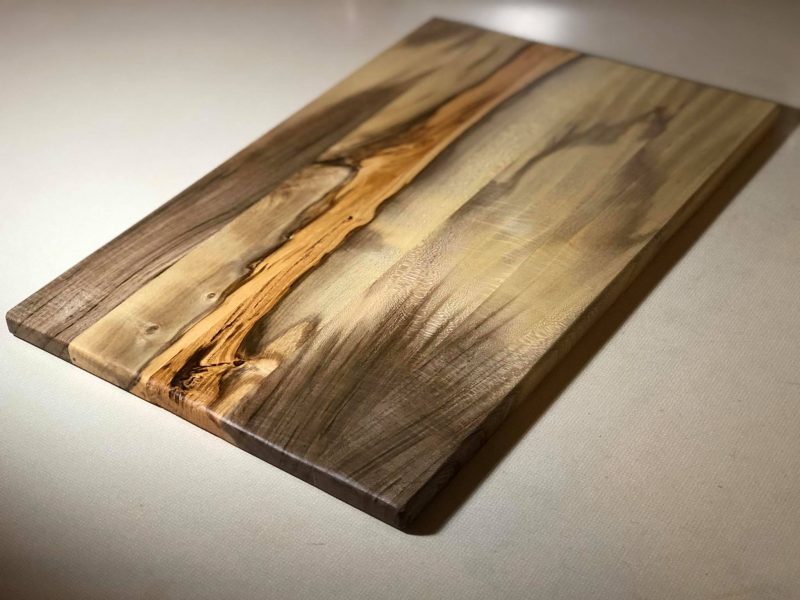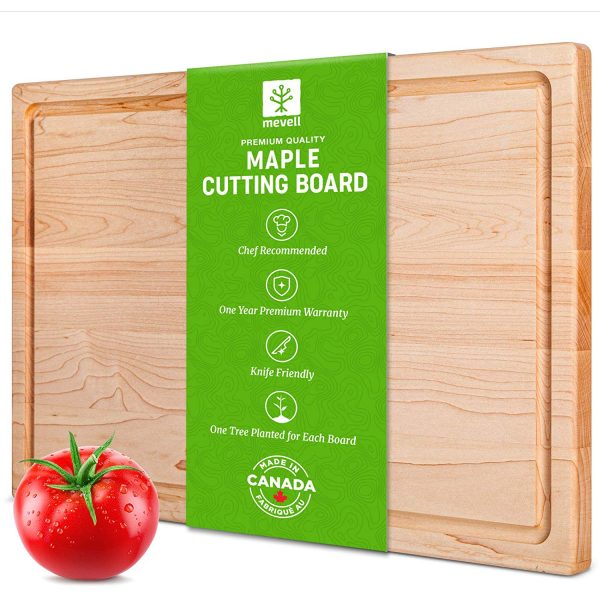After comparing some of the best types of wood for cutting boards and the most popular products from each category, we recommend the Maple Cutting Board by Mevell for its overall performance and reputation.
Picture yourself working in the kitchen: There’s a good chance that your imaginary scene involves some chopping and slicing. From vegetables to desserts, there are many foods that get cut up before they’re cooked or served. And if you don’t have a good vegetable chopper, the next best thing is a solid cutting board that can be your culinary canvas for chopping, dicing and more.
The best place to take care of that job is on a cutting board. Wood cutting boards are reliable, and the right ones won’t dull your knives or contaminate your food. They also work well for making and preparing veggies and salads – especially after using a salad spinner to clean and dry your leafy greens.
Ahead, you’ll discover the best types of wood for cutting board and learn about using these natural boards. You’ll also find recommendations for products from the best wood cutting board brands.
Best Woods for Kitchen Cutting Boards
1. Maple
Hands down, maple is the most popular wood for a cutting board. Not just any maple will do. The most prized choice for cutting boards is hard rock maple, which is also known as sugar maple.
Maple is often chosen because of its rather neutral look; its color is light, and its grain can be subtle, so it coordinates with nearly any kitchen.
Top Maple Cutting Board: Maple Cutting Board by Mevell
The Mevell maple cutting board stands alone as one of the simplest but finest-made cutting boards on our list. It’s one of the most popular and highly recommended maple boards on Amazon, and for good reason.
Each cutting board is cut, sanded and finished by hand. They’re inspected twice and polished with a premium oil and bees wax treatment that helps each board last as long as possible. The wood is sustainably sourced in Montreal, Canada, so you’re not getting some overseas wood with an anonymous source.
Users enjoy the double-sided board that features a drip juice groove on one side and a flat, elegant surface on the other.
The board is knife friendly, meaning that cuts don’t go as deep as they do on bamboo or plastic, so it’s an easy cutting board to maintain over the years. It comes with a care guide on best use and cleanup, and Mevell plants one tree for every cutting board sold.
Best of all, there’s a 100% money-back guarantee and one year warranty, so if you need to replace your board within a year, you can do so without any questions asked.
The positive reviews suggest you won’t need to, but it’s great to have that assurance – especially if you’re cooking for a large family that will require constant use of the cutting board.
Another Good Maple Option: California Custom Millwork Reversible Maple Wood Butcher Block
This maple cutting board from California Custom Millwork is one of the best choices for people who plan to use their boards for cutting meat. It has a juice groove that runs along the border to catch the juices.
This large board measures about 20 inches by 15 inches. It is 1.25 inches thick. It’s a substantial product but not too heavy to move around your kitchen.
The cutting board is reversible, so when you don’t need the juice grooves, you can flip it over. The other side provides a completely smooth cutting surface.
2. Walnut
Another popular choice is walnut. In regard to color, this wood is the exact opposite of maple. It has a trendy dark finish that gives kitchens a modern look. Like maple, walnut is hard without being too hard.
- Top Walnut Cutting Board: John Boos Walnut Edge Grain Cutting Board with Feet
There’s no doubt about it: Boos Boards are considered the top name among the best wood cutting board brands. The company makes wood cutting boards in a variety of reliable, sturdy and beautiful styles, including this footed version made of walnut.
This is a square cutting board; it measures 12 inches on each side. That’s a comfortable size for small kitchens with limited counter space. The board itself is 1.5 inches tall, and it sits on four rounded feet. With its manageable size and attractive feet, it makes a nice serving tray in addition to a chopping block.
- Another Good Walnut Option: Virginia Boys Kitchens Walnut Wood Cutting Board with Handle
Hanging your cutting board on the wall is a convenient way to store it, and this paddle-style cutting board from Virginia Boys Kitchens lets you do just that. It also has a handle that extends away from the cutting surface so you can easily transport it around your kitchen or use it as a serving piece.
Including the handle, the board is 10 inches by 16 inches. The cutting surface itself is almost square in shape. At just under 1 inch thick, this cutting board is a bit lighter than some others.
3. Cherry
Cherry is sometimes prized for its rich color that ranges from medium to deep shades. It’s a little softer than maple and walnut, however, so it may not last as long as a board made out of walnut or oak.
- Top Cherry Cutting Board: NaturalDesign Cutting Board: Cherry, Walnut, Maple
If you can’t decide between a maple cutting board, a walnut one, or a cherry one, this NaturalDesign product might be the one for you. It’s an edge-grain board that features stripes made of maple, walnut and cherry, so you don’t have to settle for just one variety.
The wood cutting board measures 18 inches by 12 inches. At 1.2 inches high, it’s not as thick as some boards, but that makes it lighter and more portable.
Because this board is flat on both sides, it is reversible. Both sides show the beautiful striped pattern.
4. Beech
Beech is a European tree that is often used for cutting boards. It possesses many similar qualities to maple wood. It’s sufficiently hard, and it’s not overly porous, so it wears well. With time, it often picks up a beautiful red coloration.
- Top Beech Cutting Board: Artelegno Solid Beech Wood Cutting Board
Those looking for a cutting board made of beech wood will appreciate this product from Artelegno. Its light-colored finish fits into both traditional and modern kitchens. Although light wood sometimes stains easily, this board has been treated with a special stain-resistant coating.
The beech board measures 15.75 inches by 11.8 inches. It sits on four rectangular feet. Together with the feet, the unit is about 2 inches tall.
One corner of the board has an embedded magnet. This feature is handy for keeping your knife in place when you’re not chopping.
What Makes a Great Wood for Cutting Boards?
These trees are considered the best wood for cutting board for a reason. Their wood possesses certain characteristics that make them just right for clean, reliable cutting surfaces.
- Hardness
A wood’s level of hardness makes a big difference in how well it will perform as a cutting board. The best woods are hard enough to hold up to knives so that they don’t get scratched and knicked easily. Cutting boards made from softwood trees are unlikely to stand the test of time.
You might, then, think that the hardest woods are the best woods. Unfortunately, that’s not necessarily true either. If a cutting board is too hard, it can quickly dull and damage your kitchen knives.
- Tight Grain

The more solid a wood is, the better it is for use as a cutting board. Wood with a tight grain doesn’t soak up too much water, which is good. Water can damage and warp a cutting board.
- Antimicrobial
Wood cutting boards don’t typically get treated with antibacterial chemicals, but many types of wood have some natural protection against contamination. Studies have shown that the wood can trap the microbes within itself, and it does not rerelease those germs back to the surface of the wood. In other words, if you buy the right type of wood, your cutting board can be at least as sanitary as a dishwasher-safe plastic one that’s in good condition. It’s certainly more sanitary than a scratched and nicked plastic cutting board.
Maple is particularly prized for its ability to trap bacteria in this way. In fact, hard rock maple has been approved for use in commercial kitchens by NSF International.
- Safe Sourcing
All of the top wood choices are from trees that grow in North America or Europe. In fact, by and large, they are trees with edible parts. Trees that are useful as sources of nuts, fruit or syrup are unlikely to contain natural toxins that are harmful to human health, so you can feel good about putting edible items on them during food prep.
- Renewability
Wood is a good material to use for cutting boards because trees are a renewable resource. The faster a tree variety grows, the more renewable it is. Maple trees reach maturity in 30 years, which is fairly quick for a tree, and they can be harvested for their wood before they reach full maturity.
- Color
Wood can range from very light shades to very dark shades. Which you want for your kitchen is simply a matter of personal preference and decor style.
Many wood cutting boards contain beautiful patterns. These can be natural patterns from the wood grain, or they can be geometric patterns created by mixing a variety of woods into the design.
What to Look for When Shopping for Cutting Boards
The quality of a board depends not only on whether it’s made from the best wood for cutting board but also on how the product is made. Keep the following features in mind when shopping for a wood cutting board.
- Grain
Every piece of wood has three grains. The face grain is the pattern along the main length of the board. The edge grain runs along the long, narrow side of the board. Finally, the end grain is found along the short side of the board. A wood cutting board can be made of any of these parts of the board.
Of all of these options, end-grain cutting boards are the most prized because they are the strongest. They are the most resistant to cuts and marks.
Edge-grain cutting boards are the next strongest type. Face-grain boards are the weakest and don’t usually stand up nearly as well to the sharp blade of a knife.
- Thickness

The thicker a cutting board is, the less likely that it is to warp or split over time. Thick boards also have plenty of weight, so they don’t easily slip and slide around on your counter while you’re chopping or slicing. Many of the best wood cutting boards are at least 2 inches tall.
Of course, the thicker a board is, the heavier it is. For boards like this, it’s sometimes best if you can afford them a permanent place on your counter. Keep in mind that you may prefer to clean a heavy board in place rather than lugging it to the sink and back.
- Style

Wood cutting boards come in a variety of shapes and styles. Many are designed to sit on your countertop. They may be round or rectangular. Some are quite small, while others are large enough for carving a large turkey or chopping all the vegetables for a dinner salad.
Other cutting boards have feet or legs. The ones with short feet are still designed to sit on your counter. This is partly an aesthetic feature and partly a practical one; the raised board allows you to clean under the board without having to move the whole thing. Even more importantly, a board that sits up on feet gets air circulation on all sides, which is good for maintaining its quality. This style is best for heavy boards that have enough weight that they won’t slide around on the feet.
Boards with long legs aren’t intended for countertop use. Instead, these are freestanding cutting surfaces. They can be quite beautiful and can afford you additional prep space in the kitchen. Of course, your kitchen must have plenty of floor space in order for this to be a good option; otherwise, the unit will just be in the way. This type of cutting board can also be known as a chopping block.
- Special Features
Some cutting boards are designed with features that are intended to make your cooking experience easier or more enjoyable. These may include:
- Troughs for liquids: Some cutting boards have a shallow channel around the outside edge. This well can help collect runoff when you cut juicy meat.
- Non-slip surface: A cutting board may have grips or textures on the back to keep it from sliding around.
- Holes or handles: These features are not only useful for helping you pick up a cutting board, but they also increase your storage options since you can hang the board on a hook.
Which Woods Are Not Recommended?
If you’re tempted by the look of an oak cutting board, you’re not alone. Many people think that an oak cutting board would make a great addition to their kitchen. However, oak is not the best choice because it soaks up a lot of water. An oak cutting board, therefore, is quite prone to bowing, so it won’t last as long as a maple board or a walnut one.
Teak is another wood that you might want to steer clear of. It’s beautiful and popular. However, teak wood is very hard. Yes, it’s good for cutting boards to be made from hardwood trees. However, teak is so hard that it can quickly dull your knives.
Some people recommend that you avoid tropical trees for your wood cutting boards. Unlike North American and European hardwoods that are used as food sources, tropical species may contain harmful chemicals that you wouldn’t want to mix with your food. Some experts say that this is only a problem during the production processand that any food prepared on a tropical-wood board will be fine. Even still, you may want to avoid exotic tree varieties for your wood cutting boards.
Caring for Wood Cutting Boards
With proper care, a quality wood cutting board can last for years and years. Taking care of your wood board doesn’t have to be a difficult process, and once you learn what to do, you’ll find that it doesn’t take you long at all to give your board the attention that it requires.
After use, remove scraps from your cutting board before washing it with water and a mild dish soap. A scrub brush can help you get the board thoroughly clean. Never place a wood cutting board in the dishwasher.
After washing, use a towel to dry the board. Prop the board up so that both sides are exposed to air; this will help it dry the rest of the way. Leave it in this position overnight before putting it away.
If you’ve been cutting raw meat or something else that requires sanitation, it’s best to use quaternary ammonium diluted in water. This solution is more effective on wood boards than chlorine bleach.
Another way to help sanitize your board after cutting meat is to sprinkle salt over its surface. The salt can pull microbes out of the board. Salt is also good for removing moisture from your cutting board, so if your board has gotten really wet, salting it is a smart way to help extend its life.
Salt can also help you remove stains or odors from your cutting board. Sprinkle the surface with salt and rub a cut lemon over it. A splash of vinegar can be useful in this process as well.
Finally, you must oil your board on a regular basis. This keeps the wood moist so it doesn’t dry out and crack. You can use food-grade mineral oil or an oil designed especially for wood boards. Let it sit overnight, and wipe off the excess oil in the morning. Plan on doing this once a month. After applying oil, you can also treat your boards with a wood conditioner.
Adding a Wood Board to Your Kitchen
A beautiful wood cutting board has the power to make your kitchen feel both homey and professional at the same time. It’s a choice kitchen item for cooks with any amount of experience.
Of course, not just any wood cutting board will do. You want this investment to last, so it’s important to buy a solid piece that’s made of the best woods, like maple, walnut, cherry or beech. When you purchase the right board and treat it with care, it will be by your side as you prepare one dish after another for years to come.

